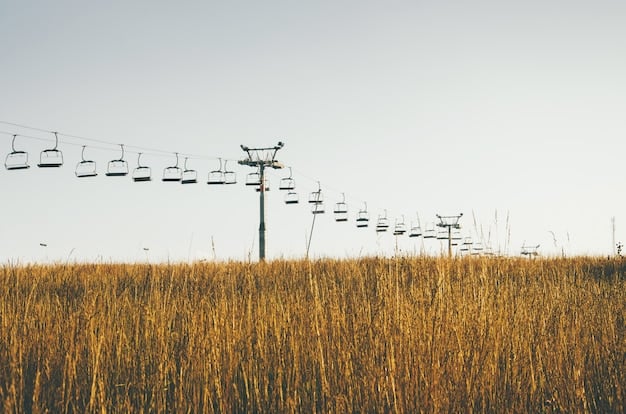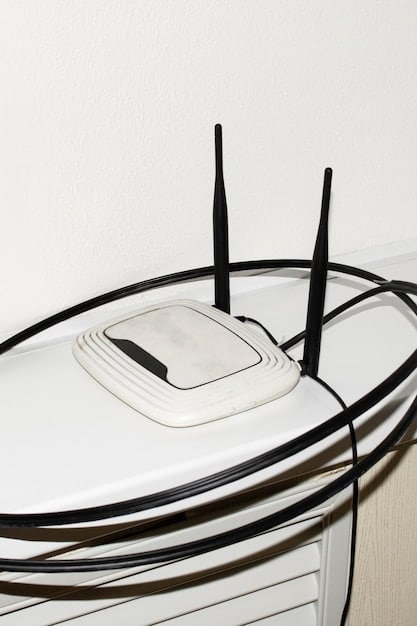5G Expansion: Transforming Rural Broadband Access in the US by 2025

5G expansion is poised to significantly impact rural broadband access in the US by 2025, offering the potential to bridge the digital divide by providing faster, more reliable internet connections to underserved communities.
The promise of how will 5G expansion impact rural broadband access in the US by 2025 is generating significant excitement and anticipation. For many rural communities, access to high-speed internet has remained a persistent challenge, hindering economic development, educational opportunities, and healthcare access.
Understanding the Current State of Rural Broadband in the US
Before diving into the potential impact of 5G, it’s crucial to understand why rural broadband access in the US is lagging in the first place. Several factors contribute to this digital divide, including geographical challenges, economic constraints, and regulatory hurdles.
The Digital Divide: A Persistent Challenge
The digital divide refers to the gap between those with and without access to modern information and communication technologies, particularly high-speed internet. In the US, this divide disproportionately affects rural communities.
Barriers to Broadband Deployment in Rural Areas
Deploying broadband infrastructure in rural areas is often more expensive and challenging than in urban centers. This is due to the low population density, rugged terrain, and lack of existing infrastructure.
- Cost of Infrastructure: Laying fiber optic cables across vast distances is a significant financial burden.
- Return on Investment: The low population density makes it difficult for providers to recoup their investments quickly.
- Regulatory Hurdles: Obtaining the necessary permits and rights-of-way can be a lengthy and complex process.
These challenges have created a situation where many rural communities are stuck with slow, unreliable internet connections, or no access at all. This limits their ability to participate in the modern digital economy and access essential services.
5G Technology: A Potential Game-Changer for Rural Areas
5G, the fifth generation of wireless technology, offers the potential to overcome many of the barriers that have hindered rural broadband deployment. With its high speeds, low latency, and increased capacity, 5G can provide a viable alternative to traditional wired solutions.

How 5G Differs from Previous Generations
5G is not simply an incremental upgrade over 4G. It represents a fundamental shift in wireless technology, with several key features that make it particularly well-suited for rural broadband applications.
Fixed Wireless Access (FWA): Bringing 5G Home
Fixed Wireless Access (FWA) is a technology that uses 5G to deliver broadband internet to homes and businesses without the need for physical cables. This is a game-changer for rural areas, where laying fiber is often cost-prohibitive.
- Faster Deployment: FWA can be deployed much faster than traditional wired solutions.
- Lower Costs: FWA eliminates the need for expensive fiber optic cables.
- Improved Performance: 5G FWA can deliver speeds comparable to fiber, with low latency.
By leveraging FWA, 5G can bring high-speed internet to rural communities quickly and affordably, leveling the playing field and opening up new opportunities.
The Expected Impact on Rural Broadband Access by 2025
By 2025, the expansion of 5G is expected to have a significant impact on rural broadband access in the US. While challenges remain, the potential benefits are substantial, and several initiatives are underway to accelerate deployment.
Increased Availability of High-Speed Internet
One of the most significant impacts will be the increased availability of high-speed internet in rural areas. 5G FWA can extend broadband coverage to areas that were previously unreachable.
Improved Internet Speeds and Reliability
5G promises not only wider coverage but also faster speeds and improved reliability. This is critical for supporting bandwidth-intensive applications like video conferencing, online learning, and telemedicine.

With faster and more reliable internet, rural residents will be able to participate more fully in the digital economy and access essential services that were previously out of reach.
Challenges and Obstacles to 5G Expansion in Rural Areas
While the promise of 5G for rural broadband is compelling, several challenges and obstacles must be addressed to ensure successful deployment and adoption. Overcoming these hurdles is critical to realizing the full potential of 5G.
Spectrum Availability and Allocation
Access to sufficient spectrum is essential for 5G deployment. However, spectrum is a finite resource, and its allocation is a complex and often contentious process.
Infrastructure Costs and Investment
While 5G FWA can reduce the cost of deployment compared to fiber, it still requires significant investment in infrastructure, including cell towers and network equipment.
- Tower Deployment: Building new cell towers can be expensive and time-consuming.
- Equipment Costs: 5G network equipment can be costly, especially for smaller providers.
- Infrastructure Upgrades: Existing infrastructure may need to be upgraded to support 5G.
Attracting the necessary investment and managing infrastructure costs are critical challenges for 5G expansion in rural areas. Government subsidies and public-private partnerships can play a vital role.
Government Initiatives and Funding for Rural Broadband
Recognizing the importance of rural broadband access, the US government has launched several initiatives and funding programs to support deployment. These efforts are crucial for bridging the digital divide and ensuring that all Americans have access to high-speed internet.
The Rural Digital Opportunity Fund (RDOF)
The Rural Digital Opportunity Fund (RDOF) is a program administered by the Federal Communications Commission (FCC) that provides billions of dollars in subsidies to broadband providers to deploy high-speed internet in unserved rural areas.
Other Federal and State Programs Supporting Broadband
In addition to RDOF, several other federal and state programs support rural broadband deployment. These programs provide grants, loans, and other incentives to encourage investment and innovation.
These government initiatives are essential for overcoming the economic barriers to rural broadband deployment and ensuring that all Americans have access to the opportunities of the digital age.
The Future of Rural Broadband Beyond 2025
While 2025 represents an important milestone, the future of rural broadband extends far beyond. As technology evolves and deployment efforts mature, rural communities can expect even greater access to high-speed internet.
Emerging Technologies and Innovations
Beyond 5G, other emerging technologies and innovations are poised to further enhance rural broadband access. These include satellite internet, low-Earth orbit (LEO) satellites, and advanced wireless technologies.
These technologies hold the potential to provide even greater coverage, faster speeds, and lower costs, further leveling the playing field for rural communities.
| Key Point | Brief Description |
|---|---|
| 🚀 5G Potential | 5G offers faster, reliable internet via Fixed Wireless Access (FWA). |
| 💰 Funding | Government programs like RDOF support rural 5G deployment. |
| 🚧 Challenges | Spectrum access, infrastructure costs, and regulation can slow progress. |
| 🛰️ Future Tech | LEO satellites and advanced wireless are shaping future access. |
Frequently Asked Questions
▼
5G is the fifth generation of wireless technology, providing faster speeds and lower latency. It uses radio waves to transmit data wirelessly, enabling faster mobile and broadband internet connections by utilizing high radio frequencies.
▼
Fixed Wireless Access (FWA) uses 5G to deliver broadband internet to homes and businesses without physical cables. A 5G modem receives signals from a cell tower, providing high-speed internet wirelessly.
▼
5G improves rural lives by providing faster Internet access, enabling remote education, telemedicine, and economic growth. Fast access can help close the digital gap between urban and rural areas.
▼
The main obstacles include the high costs of infrastructure deployment, regulatory hurdles, and gaining access to sufficient spectrum. These factors can slow down and affect 5G introduction and expansion.
▼
Government initiatives like the Rural Digital Opportunity Fund (RDOF) offer billions in subsidies to companies deploying broadband in rural areas. Also other federal programs provide grants and incentives.
Conclusion
The expansion of 5G offers a transformative opportunity to bridge the digital divide with faster and reliable mobile communication in US by 2025. Overcoming various challenges through government and private cooperation as well as embracing new technologies is essential.





